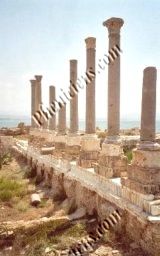
Driveway with Columns.
The city of Tyre
Tyre (Sour today, Sor in Phoenician, meaning the rock) is the most southern of the Phoenician cities. Located 70 km south of Beirut, it is now at the end of a peninsula, on a rocky promontory, connected to the Lebanese coast by a sandy area. The first inhabitants of the place occupied the small island, just 600 m from the shore. In the first millennium Tyre was a bipolar city with an island connected by a ford with the shore (which will be later expanded during the siege of Alexander the Great in 332 BC), where some other neighborhoods were built as extensions of the islands, called: Ushu (or Uzzu) in ancient texts, and afterwards, Palaetyrus (Tyre-the-old) by the Greeks.
The first archaeological excavations were carried out in March 1861 by Ernest Renan. He endeavored to rediscover the history of this rich and ancient city, meticulously described by the prophet Ezekiel. Between 1924 and 1936, the Reverend Father Antoine Poidebard, French aviator and archaeologist, had undertaken a submarine and aerial survey, a first of its kind. The results of his exploration demonstrated a port complex, protected by a natural barrier reef, reinforced by artificial moles. Various excavations followed, particularly those carried out by the Emir Maurice Chehab, Lebanese senior official and archaeologist, but the historical restoration of the site was difficult since the remains of the city, particularly the Phoenician layers, were obliterated by the successive occupations (Hellenistic, Roman, Byzantine, Arab, Frankish, ...) and by concentrated urbanization.
These multiple archaeological excavations in the city and its surroundings, have confirmed the occupation of the site since the third millennium, with permanent habitation from the Early Bronze Age. The concordance of archaeological discoveries with tradition preserved by the priests of Melqart, was documented by Herodotus, who established that the city and the temple were founded around 2750 BC.
The glory of Tyre was mainly due to its maritime power. The city presents itself as the most powerful Phoenician cities, with its two ports: the North Port, known as "Sidonian", always used, and the "Egyptian" port in south, disused since the Byzantine presence in the region.
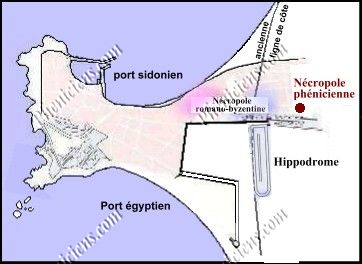
Plan of the city of Tyre.
In the fourteenth century, according to the letters of El-Amarna, the king of Tyre, Abi-Milku, asked Pharaoh to attribute to him some mainland in front of the island, since he lacked water, as well as wood, straw and clay, Adding that "there is no place where we can bury our dead"(1), but, in turn, the King of Gobal (Byblos) was complaining to Pharaoh that "the domain of Tyre is as wide as the sea".
The principal temple of the city, dedicated to Melqart, was erected by King Hiram I tenth century BC, over the location of an earlier temple in ruins. The facade was preceded by two pillars or columns, one with gold and the other of emerald. It was not possible to properly determine the location of this famous temple, but it is probable that it is in the Crusader cathedral, where excavations of Maurice Chehab, unveiled the remains of Phoenician imposing buildings. Other temples have been constructed in the city: that of Astarte, Baal...
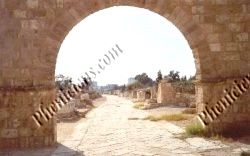
Tyre - triumphal arch.
Tyre was best known through its special relations with the Kingdom of Israel. The first Book of Kings (Bible) describes the friendly relations in the tenth century between king of Tyre Hiram and Solomon king of Israel. Hiram had furnished the cedar wood, and made available masons to build the temple in Jerusalem, desired by Solomon. This relationship between the two kingdoms was consolidated with the marriage of Jezebel, daughter of Ithobaal king of Tyre, and Achab king of Israel.
The historian Pliny noted that Tyre was known in ancient times, especially for its overseas activities and its geographical position, "in the middle of the sea", inviting poets to compare it to a boat. The expansionary reputation of the city was brought about by two significant events, belonging more to legend than to historical truth. The first concerns the propagation of the Phoenician alphabet in Greece by Cadmus, son of King Agenor (founder of the city), during his journey in search of his sister the Princess Europa who was kidnapped by Zeus. The second fact is related to the founding of Carthage by the Princess Elissa (Dido in the Latin tradition), sister of King Pygmalion of Tyre.
This attraction towards the sea can also be explained by a desire to preserve some autonomy. The Tyrians have opposed the greatest invaders on several occasions. The position of the city, island in the middle of the waves, its maritime richness as well as the expansion of its sailors, attracted conquering cravings. Like other Phoenician cities on the coast, it became part of successive empires that settled throughout the centuries (Egyptian, Assyrian, Babylonian, Persian, Greek ...) but its annexation has not always been peaceful. It resisted to the siege of Nebuchadnezzar king of the Babylonians for thirteen years. The Tyrians opposed Alexander the Great, who could not conquer it, even after seven months of siege, following the construction of a breakwater connecting the island to the mainland.
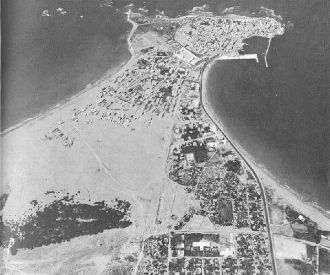
Overview of the city of Tyre.
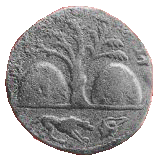
Money - Dog, Murex
220-221 AD, Tyre, Roman period.
One of the most characteristic activities of Tyre was the extraction and the purple industry. This production was so typical of the Phoenicians that it could be at the origin of their name (Phoinix in Greek means purple). As per legend, the purple discovery is attributed to Melqart-Heracles. While the God was walking along the beach with the nymph Tyros, his dog found a Murex and munched on it, and its jaw was tinged with purple color. The nymph admired the color and asked God to offer her some clothing of such a beautiful color. Melqart procured many murex and ordered to have a tunic dyed which he presented to the nymph.
From all the Phoenician cities, Tyre was the most famous in the production of this coloring substance. This was obtained from a seashell, the murex. These shellfish were recovered from the sea in the early spring, during the reproduction period and before spawning, and transported to the shore where they were placed in large vats. There, the mollusks were crushed in order to release the colored pigment contained therein. The collected liquid was mixed with sea salt, and three days later was transferred to stone or lead tanks. After ten days, the dye would rise to the surface where it was easily collected. It could obtain different shades of purple, from red to pink, through to purple more or less intense, depending on whether the dye was diluted with sea water or exposed to sunlight.
This substance, with refined colors was used for textile dyeing (wool pieces, linen or fine cotton) and leather. These products enjoyed an international economic prestige, also related to the excellence of the Phoenicians weavers. The Old Testament, the Assyrian annals and Homer testify the famous Phoenician purple, each in (their) his own approach. The importance of such production has pushed the Tyrians to make it the emblem of their city, and to use it to illustrate their coins.
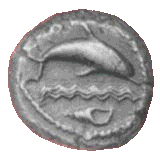
Money - Dauphin, Murex
Tyre, 480 BC.
| (1) |
Gras, Rouillard & Texidor, l'Univers Phénicien, Hachette Pluriel, 1995, P56 |
Retour texte |





